- Scientific Name: Persea americana Miller
- Common Names: avocado, avocado-pear, aguacate (Spanish)
- Family: Lauraceae
- Origin: Avocados are indigenous to tropical America. Three ecological races—Mexican, Guatemalan, and West Indian—are recognized (Table 1).
- Distribution: Avocados are grown in tropical and subtropical areas of the world. In Florida, commercial production is primarily in Miami-Dade and Collier Counties (Figure 1), however, small plantings and isolated trees are found in warm locations throughout the state.
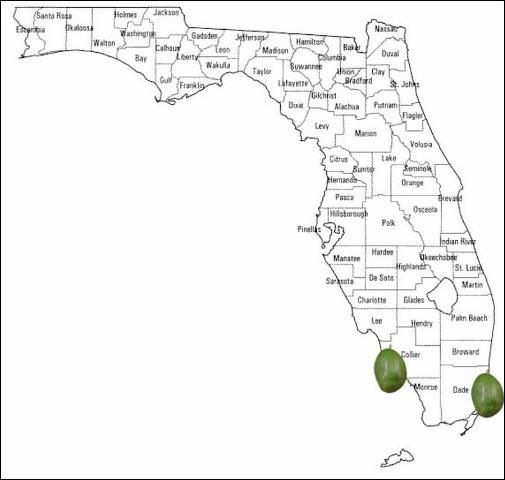
- History: Avocados have been cultivated in tropical America since pre-Columbian times. The first recorded importation into Florida was in 1833 and into California in 1856.
- Importance: One of the important fruits in the American tropics, the avocado is grown commercially in many areas of the world including Mexico, Brazil, Dominican Republic, Australia, Israel, Chile, tropical Africa, Spain, and Indonesia. In the U.S. avocados are produced in California, Florida, Puerto Rico, Hawaii, and Texas.
Description
Tree
A medium (30 ft; 9.1 m) to large (65 ft; 19.8 m) tree (Figure 2), the avocado tree is classified as an evergreen, although some varieties lose their leaves for a short time before and during flowering. The tree canopy ranges from low, dense and symmetrical to upright and asymmetrical. Limbs are easily broken by strong winds or heavy crop loads.
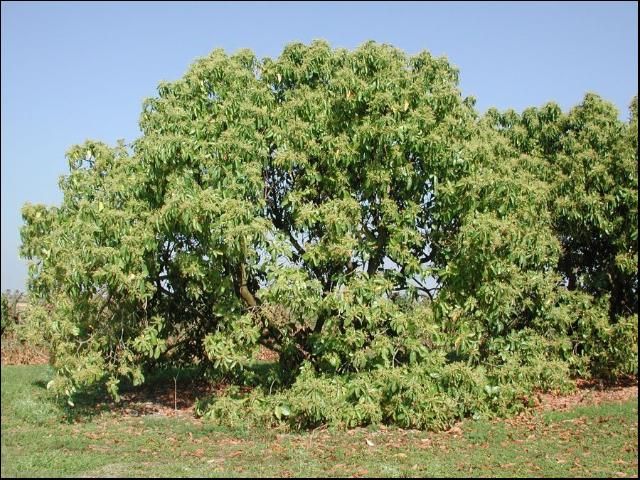
Leaves
Leaves are 3 to 16 inches (7.6 to 41.0 cm) in length and variable in shape (elliptic, oval, lanceolate) (Figure 3). They are often hairy (pubescent) and reddish when young, then become smooth, leathery, and dark green when mature.
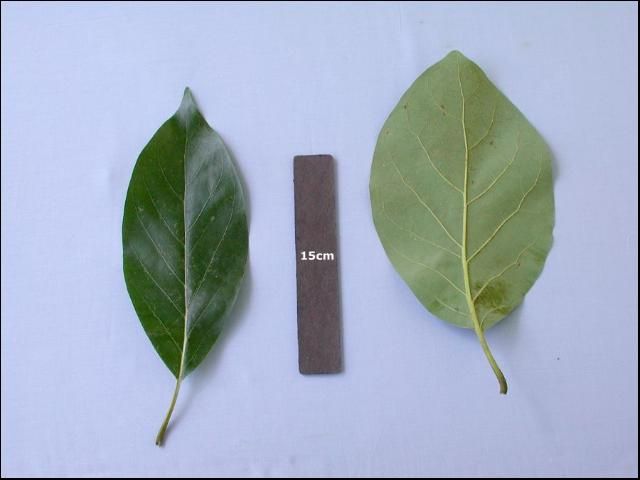
Credit: Ian Maguire IFAS/TREC
Inflorescence (Flowers)
The many-flowered lateral inflorescences (structures that hold the flowers) are borne in a pseudoterminal position (Figure 4). The central axis of the inflorescence terminates in a shoot. Flowers are perfect, yellowish-green, and 3/8 to 1/2 inch (1 to 1.3 cm) in diameter (Figure 5).
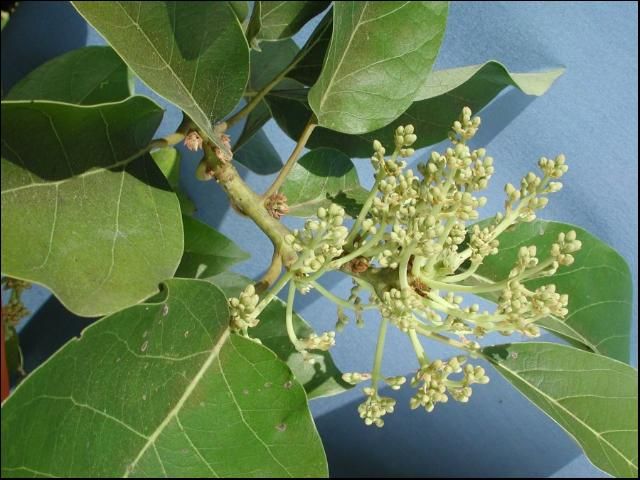
Credit: Ian Maguire IFAS/TREC
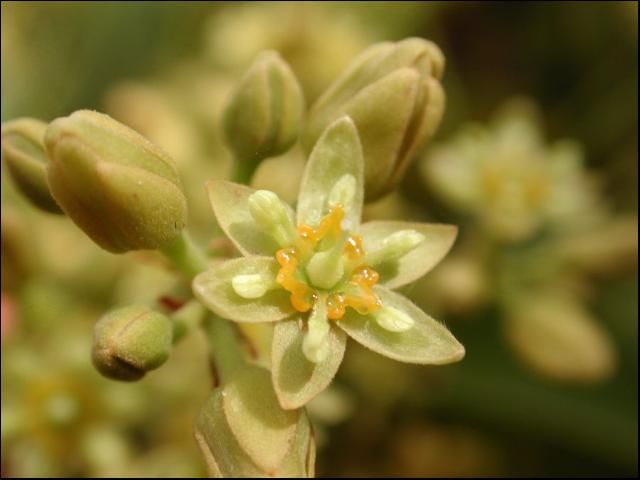
Fruit
The fruit is a berry, consisting of a single large seed, surrounded by a buttery pulp (Figure 6). Florida avocado varieties contain 3 to 15% oil. The skin is variable in thickness and texture. Fruit color at maturity may be green, black, purple or reddish, depending on variety. Fruit shape ranges from spherical to pyriform, and the fruit weigh from a few ounces to 5 lbs (2.3 kg). The fruit does not generally ripen until it falls or is picked from the tree. In Florida, the fruit is considered sufficiently mature for harvest when it reaches a specified calendar date and weight or size. The specific dates, weights, and sizes used to determine maturity vary by variety.
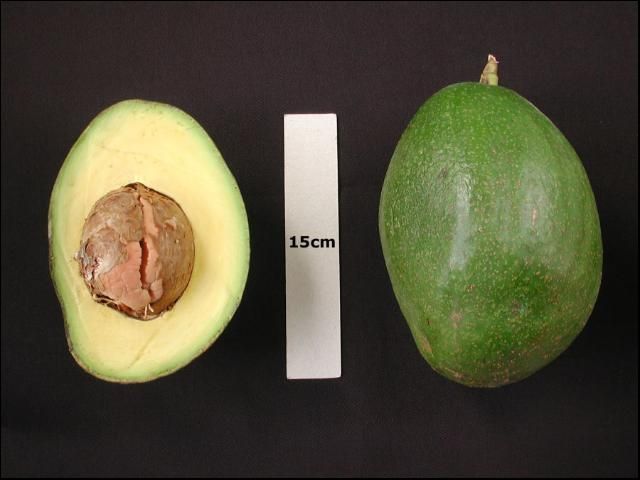
Pollination
Avocado flowers are bisexual, however, the female and male flower parts function at different times of the day. Varieties are classified into A and B types according to the time of day when the female and male flower parts become reproductively functional. New evidence indicates avocado flowers may be both self- and cross-pollinated under Florida conditions. Self-pollination occurs during the second flower opening when pollen from the anthers is transferred to the stigma of the female flower parts. Cross-pollination may occur when female and male flowers from A and B type varieties open simultaneously. Self-pollination appears to be primarily caused by wind, whereas cross-pollination is caused by large flying insects such as bees and wasps.
Varieties vary in the degree of self- or cross-pollination necessary for fruit set. Some varieties, such as 'Waldin', 'Lula', and 'Taylor' fruit well when planted alone. Others, such as 'Pollock' and 'Booth 8' (both B types) do not and it is probably advantageous to plant them with other varieties (A types) which bloom simultaneously to facilitate adequate pollination and fruit set. Before planting an avocado tree, homeowners should scout their neighborhood for other home landscapes with avocado trees. If other home landscapes possess avocado trees then most likely adequate pollination will occur by planting just one avocado tree, if no other avocado trees are within your immediate area, you may opt to plant two avocado trees, one an A-type, the other a B-type (see Table 2). This will help insure good pollination and fruit set.
Varieties
Avocado varieties are classified in three groups, known as the West Indian, Guatemalan and Mexican "races". West Indian avocados originated in the tropical lowland areas of southern Mexico and Central America whereas the Guatemalan and Mexican avocados originated in mid-altitude highlands in Guatemala and Mexico. The distinguishing characteristics of the three races is summarized in Table 1. In Florida, most early season varieties are West Indian types, whereas midseason and late varieties are mostly Guatemalan-West Indian hybrids or Guatemalan types and therefore have intermediate characters between the two races. Some characteristics of Florida avocado varieties are summarized in Table 2.
Climate
West Indian and some hybrid varieties are best adapted to a lowland tropical climate and relatively frost-free areas of the subtropics. Mexican varieties are more cold-tolerant and not well-adapted to lowland tropical conditions. Guatemalan x Mexican hybrids are generally more cold-tolerant than West Indian x Guatemalan hybrid varieties.
In general, avocados should be planted in the warmest areas of the State, i.e., along the southeast and southwest coasts of Florida. West Indian and some hybrid types are the least cold tolerant and do best only in areas that rarely experience freezing temperatures (Table 1). Varieties with little cold-tolerance include 'Donnie', 'Dupuis', 'Simmonds', 'Pollock', 'Nadir', 'Hardee', and 'Waldin'. Other varieties such as 'Tonnage', 'Taylor', 'Lula', 'Kampong', 'Meya', and 'Brookslate' are more cold tolerant and may be planted in areas that experience infrequent but below freezing temperatures (24°F–28°F). Moderately cold-tolerant types (25°F–30°F) include 'Beta', 'Choquette', 'Loretta', 'Booth 8', 'Hall', 'Monroe', and 'Reed'. Mexican and Mexican hybrid varieties such as 'Brogdon', 'Ettinger', 'Gainesville', 'Mexicola', and 'Winter Mexican' are even more cold-tolerant and may withstand temperatures in the low 20s. However, these varieties may be difficult to find in the nursery trade.
Propagation
Most avocado varieties do not come true from seed (i.e., a seed will not render the same variety), so they must be propagated vegetatively (Figures 7 and 8). Cleft grafting is the preferred method of propagation in Florida, although veneer grafting is also used. Young, vigorously growing seedlings are used for rootstocks, and terminals of leafy shoots are used for scion material. Grafting is most successful during the cooler months from November through February or March, but can be done from June through March if plant material is available. Established trees may be top-worked by cleft or veneer grafting scions of the desired varieties on stumps of cut-back trees or by veneer grafting new shoots arising from stumped trees. Propagation by cuttings and air-layering has not been successful.
Typically, seedlings of 'Lula' and 'Waldin' are used as rootstocks in Florida because of their uniformity, vigor, and availability of seeds.
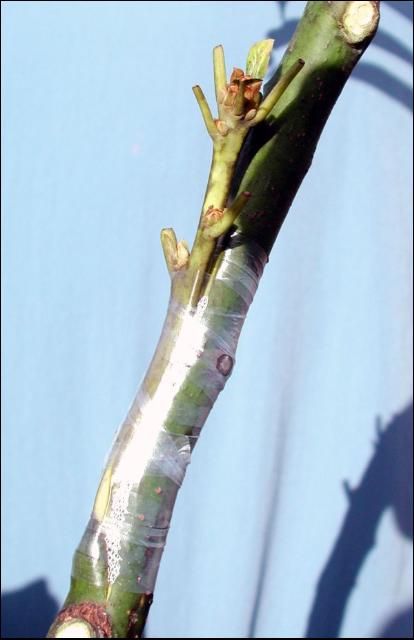
Credit: Ian Maguire IFAS/TREC
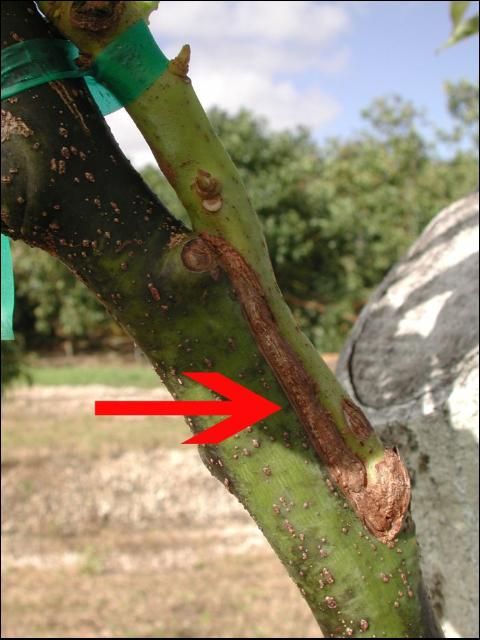
Production (Crop Yields)
Less than 1% of the flowers on an avocado tree ultimately produce fruit. Some varieties set a large number of fruit, most of which drop (fall) during early summer, while others set fewer fruit but retain most of them to maturity. Varieties differ in productivity and in regularity of bearing, some producing a large crop only every other year. Trees that are under a good cultural program (i.e., fertilized and watered) have less of a tendency to alternately bear.
Grafted trees begin to produce after 3 to 4 years. In Florida, yields of mature trees average 2 to 3 bushels per year (110 to 165 lbs; 50 to 75 kg). However, with good management, considerably better production can be expected. Avocado varieties in Florida mature from June to March (Table 2). Planting more than one variety will prolong the avocado season from the home landscape.
Spacing and Pruning
Planting distances depend on soil type and fertility, current technology, and expertise of the homeowner. Avocado trees in the home landscape should be planted 23 to 30 feet or more (7.0 to 9.1 m) away from buildings and other trees. Trees planted too close to other trees or structures may not grow normally or produce much fruit due to shading.
Soils
Avocado trees do not tolerate flooding or poorly drained soils but are adapted to many types of well-drained soils. Continuously wet or flooded conditions often result in decreased growth and yields, nutrient deficiency symptoms, dieback, and sometimes tree death. Under these conditions, trees are highly susceptible to root infection by Phytophthora fungi.
Trees grow well and produce satisfactory yields in the sandy and limestone soils of Florida if not subjected to flooding or poor drainage. In the home landscape, select an area that does not flood. If there is a potential for excessively wet or flooded soil conditions plant on a large hill or mound made up of native soil, 2 to 4 ft high (0.6 to 1.2 m) by 4 to 6 ft diameter (1.2 to 1.8 m).
Planting an Avocado Tree
Properly planting an avocado tree is one of the most important steps in successfully establishing and growing a strong, productive tree. The first step is to choose a healthy nursery tree. Commonly, nursery avocado trees are grown in 3 gallon containers and these trees stand 2 to 4 ft from the soil media. Large trees in smaller containers should be avoided as the root system may be "root bound". This means all the available space in the container has been filled with roots to the point that the tap root is growing along the edge of the container in a circular fashion. Root bound trees may not grow properly once planted in the ground. Inspect the tree for insect pests and diseases and inspect the trunk of the tree for wounds and constrictions. Select a healthy tree and water it regularly in preparation for planting in the ground.
Site Selection
In general, avocado trees should be planted in full sun for best growth and fruit production. Select a part of the landscape away from other trees, buildings and structures and powerlines. Remember avocado trees can become very large if not pruned to contain their size. Select the warmest area of the landscape that does not flood (or remain wet) after typical summer rainfall events.
Planting in Sandy Soil
Prior to digging a hole, remove a 3 to 10 ft diameter ring of grass sod. Dig a hole 3 to 4 times the diameter and 3 times as deep as the container the avocado tree has come in. Making a large hole loosens the soil adjacent to the new tree making it easy for the roots to expand into the adjacent soil. It is not necessary to apply fertilizer, topsoil, or compost to the hole. In fact, placing topsoil or compost in the hole first and then planting on top of it is not desirable.
Backfill the hole with some of the native soil removed to make the hole. Carefully remove the tree from the container and place it in the hole so that the top of the soil media of the container is level with or slightly above the surrounding soil level. Fill soil in around the tree roots and tamp slightly to remove air pockets. Immediately water the soil around the tree and tree roots. Staking the tree with a wooden or bamboo stake is optional. However, do not use wire or nylon rope to tie the tree to the stake as they may eventually damage the tree trunk as it grows. Use a cotton or natural fiber string that will degrade slowly.
Planting in Rockland Soil
Many areas in Miami-Dade County have a very shallow soil and several inches below the soil surface is a hard calcareous bedrock . Remove a 3 to 10 ft diameter ring of grass sod. Make a hole 3 to 4 times the diameter and 3 times as deep as the container the avocado tree has come in. To dig a hole there are several options: use a pick and or a digging bar to break up the rock or contract with a company that has augering equipment or use a backhoe. Plant as directed in the proceeding section for sandy soil.
Planting on a Mound
Many areas in Florida are within 7 ft or so of the water table and experience occasional flooding after heavy rainfall events. To improve plant survival, consider planting fruit trees on a 2 to 3 ft high by 4 to 10 ft diameter mound of native soil.
After the mound is made, dig a hole 3 to 4 times the diameter and 3 times as deep as the container the avocado tree has come in. In areas where the bedrock nearly comes to the surface (rockland soil) follow the recommendations for the previous section. In areas with sandy soil follow the recommendations from the section on planting in sandy soil.
Care of Avocado Trees in the Home Landscape
To promote growth and regular fruiting, avocado trees should be periodically fertilized and watered and insects, diseases, and weeds controlled on an as needed basis (Table 3).
Fertilization
In Florida, young trees should be fertilized every 1 to 2 months during the first year, beginning with 1/4 lb (114 g) of fertilizer and increasing to 1 lb (455 g) per tree (Table 4). Thereafter, 3 or 4 applications per year in amounts proportionate to the increasing size of the tree are sufficient but, not to exceed 20 lbs per tree per year.
Fertilizer mixtures containing 6 to 10% nitrogen, 6 to 10% available phosphorus petnoxide, 6 to 10% potash, and 4 to 6% magnesium give satisfactory results with young trees. For bearing trees potash should be increased to 9 to 15% and available phosphoric acid reduced to 2 to 4%. Examples of commonly available fertilizer mixes include 6-6-6-2 [6 (N)-6 (P2O5)-6 (K2O)-2 (Mg)] and 8-3-9-2 [8 (N)-3 (P2O5)-6 (K2O)-3 (Mg)].
From spring through summer, trees should receive 3 to 4 annual nutritional sprays of copper, zinc, manganese, and boron for the first 4 to 5 years. Thereafter, only zinc, manganese, and possibly boron applications are necessary. Avocado trees are susceptible to iron deficiency under alkaline and high pH soil conditions. Iron deficiency can be prevented or corrected by periodic soil applications during the late spring and summer of iron chelates formulated for alkaline and high soil pH conditions (Table 4).
Irrigation (Watering)
Newly planted avocado trees should be watered at planting and every other day for the first week or so and then 1 to 2 times a week for the first couple of months. During prolonged dry periods (e.g., 5 or more days of little to no rainfall) newly planted and young avocado trees (first 3 years) should be well watered twice a week. Once the rainy season arrives, irrigation frequency may be reduced or stopped.
Once avocado trees are 4 or more years old irrigation will be beneficial to plant growth and crop yields during prolonged dry periods. The specific water requirements for mature trees have not been determined. However, as with other tree crops, the period from bloom and through fruit development is important and drought stress should be avoided at this time with periodic watering.
Insect Pests
Many insect pests attack avocados, but they seldom limit fruit production significantly. Insect infestations are not predictable and control measures are justified only when large populations occur. Currently, the most important insect pests in Florida are:
- Avocado Looper (Epimecis detexta )
- Pyriform Scale (Protopulvinaria pyriformis )
- Dictyospermum Scale (Chrysomphalus dictyospermi )
- Avocado Red Mites (Oligonychus yothersi )
- Borers (e.g., Ambrosia beetles, Xylosandrus sp.)
- Avocado Lace Bugs (Acysta perseae )
- Red-banded Thrips (Selenothrips rubrocinctus ) (Figure 9)
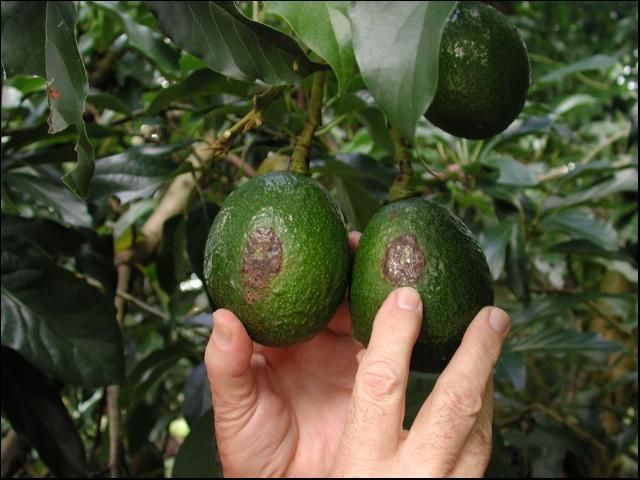
Credit: Ian Maguire IFAS/TREC
Homeowners should contact their local UF/IFAS Extension office for recommended control measures.
Diseases
Disease control for avocado trees in the home landscape is usually not warranted. The easiest method for avoiding disease problems is to grow scab resistant varieties, planting trees only in well drained soils, and monitoring the tree (leaves and fruit specially) during the year.
Successful control of foliar and fruit diseases caused by fungi requires that all susceptible parts of the plant be thoroughly coated with the fungicide before infection occurs. Sprays applied after infection (which usually occurs several days before the disease is evident) often have limited to no effect on disease development. Sprays must be re-applied as new tissues become exposed by growth and as spray residues are reduced by weathering. A successful program depends on:
- Use of the right amount of a recommended fungicide and adjuvant, if required.
- Timely applications before infection is most likely to occur.
- Thorough coverage of susceptible parts.
Homeowners should contact their local UF/IFAS Extension office for current control recommendations for the diseases discussed below.
Cercospora spot (Cercospora purpurea). Infection appears on fruits and leaves as small, angular, dark brown spots which coalesce to form irregular patches. These spots have a yellow halo. Fruit lesions are frequently the point of entry for other decay organisms, such as the anthracnose fungus. Infection usually occurs during the summer months. If Cercospora spot is a problem begin a spray program for Cercospora prevention about May 1st and continue until harvest.
Avocado scab (Sphaceloma perseae). The scab fungus readily infects young, succulent tissues of leaves, twigs and fruit. These tissues become resistant as they mature. Lesions appear as small, dark spots visible on both sides of the leaves. Spots on leaf veins, petioles and twigs are slightly raised, and oval to elongated. Severe infections distort and stunt leaves. Spots on fruits are dark, oval and raised and eventually coalesce to form cracked and corky areas which impair the appearance but not the internal quality of the fruit (Figure 10). Begin a spray program for scab prevention when bloom buds begin to swell and continue spraying until harvest. Many avocado varieties are resistant or moderately resistant to scab and no control is necessary. Some varietes such as 'Lula' are very susceptible to scab and are not recommended for planting in the home landscape.
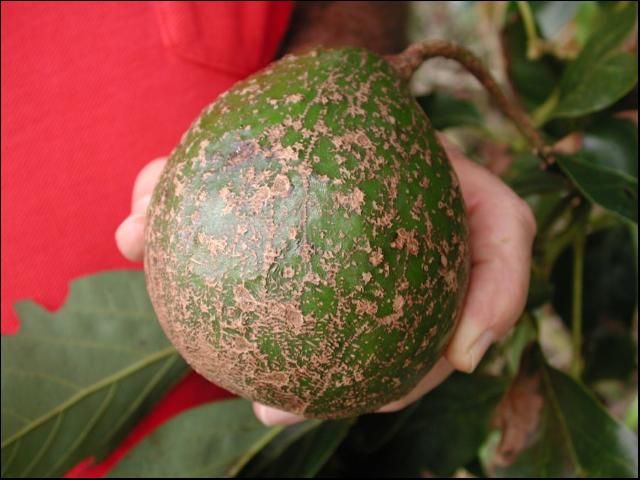
Credit: Ian Maguire IFAS/TREC
Anthracnose (Colletotrichum gloeosporoides). Anthracnose infection is important only on fruits. Infections occur through lesions caused by other organisms such as scab and Cercospora spot, or mechanical injuries. The fungus does not develop in actively growing fruits but causes a rot as the fruit ripens. Fruit lesions start as circular brown to black spots which enlarge, become sunken and crack.
Avocado root rot (Phytophthora cinnamomi ). Trees in areas with poorly drained soils and/or which are subject to flooding are likely to be affected by this fungus. This is the most serious disease in most avocado producing areas of the world. Although many trees are infected with the fungus in Florida, the disease appears to be serious only if trees are subjected to flooded conditions. Leaves of infected trees may be pale green, wilted, or dead, and terminal branches die back in advanced stages of the disease. Feeder roots become darkened and decayed, and severely affected trees usually die.
Powdery mildew (Oidium sp.). Powdery mildew covers undersides of leaves with a white powdery growth. Later, the white mildew disappears leaving dark, reticulate markings, which appear from the upper side as yellowish areas. Usually not serious enough to require control measures, this disease is most prevalent during the dry season.
Sun-blotch (Caused by a viroid). Symptoms of infection include sunken yellow or whitish streaking or spotting and distortion of twigs, leaves, and fruit (Figure 11). It is transmitted through buds, seeds, and root-grafting of infected trees. There is no control for this disease, and infected trees should be destroyed. This disease is rare in Florida.
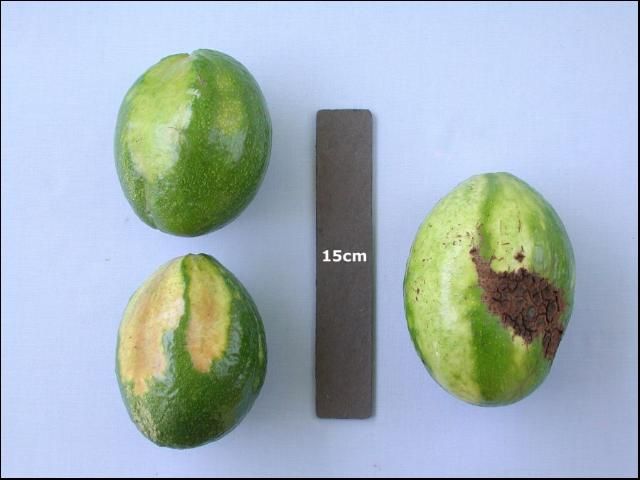
Credit: Ian Maguire IFAS/TREC
Algal Leaf Spot (Cephaleuros sp.). Symptoms appear first on upper leaf surfaces as green, yellowish-green, or rust-colored, roughly circular spots. This disease is most prevalent during summer and fall months.
Diplodia Stem-end Rot (Diplodia sp.). This rot disease begins at the stem end of the fruit and develops as the fruit softens. It is usually only a problem with immature fruit after harvest and can be prevented by harvesting only mature fruit.
Avocado Trees and Lawn Care, Weed Control, and Mulch
Avocado trees in the home landscape are susceptible to trunk injury caused by lawn mowers and weed eaters. Never hit the tree trunk with lawn mowing equipment and never use a weed eater near the tree trunk. Mechanical damage to the trunk of the tree will result in weakening the tree and if severe enough can cause the tree to dieback or die. Do not use weed and feed products around or near the base of tropical fruit trees as this may cause them to decline.
The easiest way to prevent weeds from becoming established adjacent to the tree is to maintain a grass-free area 2 to 5 ft or more away from the trunk of the tree. Mulching avocado trees in the home landscape helps retain soil moisture, reduces weed problems adjacent to the tree trunk, and improves the soil near the surface. Mulch with a 2 to 6 inch (5–15 cm) layer of bark, wood chips, or similar mulch material. Keep mulch 8 to 12 inches (20–30 cm) from the trunk to prevent rotting of the base of the tree.
Roots of mature avocado trees spread beyond the drip-line of the tree canopy and heavy fertilization of the lawn adjacent to avocado trees is not recommended and may reduce fruiting and or fruit quality. The use of lawn sprinkler systems on a timer may result in over watering and cause avocado trees to decline. This is because too much water, too often is being applied which results in root rot.
Pruning
Formative pruning during the first 2 years may be desirable to encourage lateral branching and growth. After several years of production it is desirable to cut back the tops of the trees to 10 to 15 feet (3.1 to 4.6 m). Selectively removing a few upper limbs back to their origin (crotches) each year will help prevent the loss of the lower tree canopy due to shading by the upper canopy. In addition, maintaining a smaller tree facilitates tree care and fruit harvest, makes it easier to spray the tree, and greatly reduces possible storm damage. Do not remove lower tree branches.
Pruning should be done soon after harvest for early varieties, but after danger of frost has passed for late varieties. Severe pruning is sometimes used to reduce tree height or width of very large trees. It does not injure avocado trees, but reduces fruit production for one to several seasons. Once avocado trees become 30 ft (9.1 m) or taller extreme caution should be used in pruning the trees. Climbing trees to prune them is dangerous and not recommended. Pruning of large avocado trees should be done by a professional arborist that is licensed and insured.
Harvest, Ripening, and Storage
Avocado fruits do not ripen on the tree. In general, avocado varieties may be harvested anytime during their season of maturity (Table 2). Use this as your guide as to when picking your fruit may begin. However, slight year-to-year variations occur in when maturity begins. The easiest way to determine if your avocados are ready to harvest is to harvest one large fruit and place it on your kitchen counter top. A mature fruit ripens in 3 to 8 days after it is picked. If the fruit does not ripen properly (e.g., shrivels, becomes rubbery or exhibits stem end rot), select another fruit (again larger fruit are generally more mature than smaller fruit at the beginning of the season) and repeat the test.
The fruit from an avocado tree does not all have to be harvested at the same time. This feature allows you to leave the fruit on the tree and pick fruit only when you want to eat it. Remember, it takes 3 to 8 days from the time you pick a fruit until it ripens and is ready to eat. As the season of harvest for any given variety passes there is an increased chance the fruit will fall from the tree. So although avocado fruit can be held on the tree, eventually they will drop.
Florida avocados ripen best at temperatures of 60° to 75°F (16° to 24°C). At higher temperatures, fruit ripen unevenly and develop off-flavors. The lowest safe storage temperatures before fruit ripen are 55°F (13°C) for West Indian and 40° F (4°C) for most other Florida varieties. Chilling injury is characterized by a browning or darkening of the skin and/or grayish-brown discoloration of the flesh. After fruit ripen they may be stored in the refrigerator.
Uses and Nutrition
Compared to other fruits, avocados are highly nutritious, a good source of potassium and a moderate source of Vitamin A (Table 5). Avocado fruit does not contain cholesterol, and many Florida varieties have less total fats than California varieties.
Cooking impairs flavor and appearance of avocados, but many satisfactory frozen products can be prepared. The most popular ways of serving the avocado are in salads, as appetizers, dips, and as "guacamole". The avocado has a variety of culinary uses and the delicate flavor appeals to the gourmet.